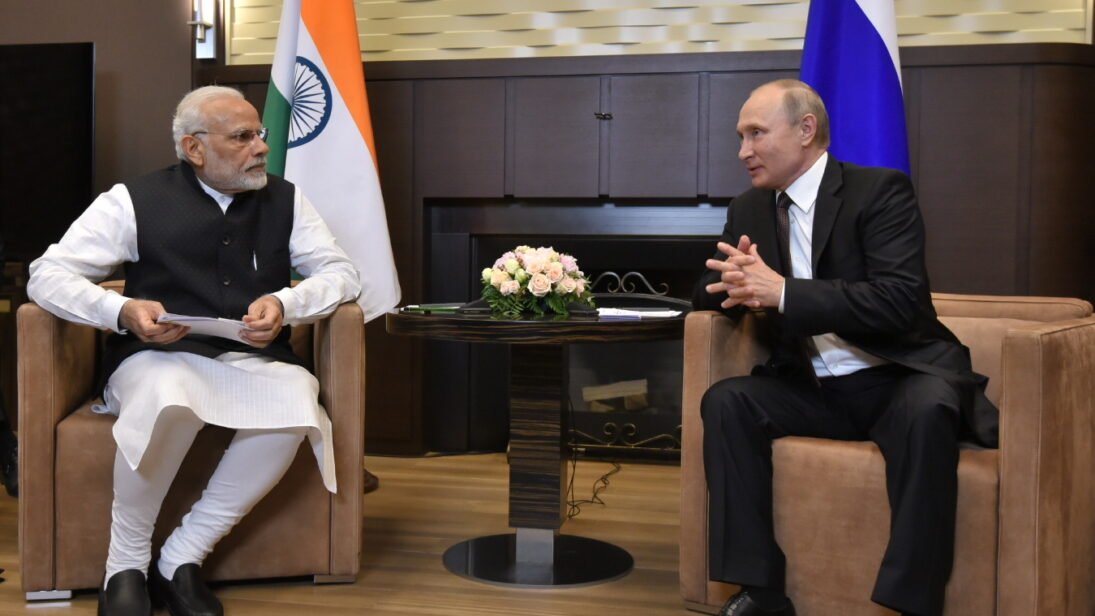Russia-U.S. Closeness and Its Impact on India’s Defense Strategy
The recent developing diplomatic realignment between Russia and the United States has emerged as a prime consideration in the formulation of India’s defense strategy (i). Traditionally, India maintained a strategic autonomous balance between robust ties of defense cooperation with Russia and its emerging strategic partnership with the U.S. toward closer cooperation, for the coordination between Moscow and Washington can eventually have dramatic consequences for New Delhi in the context of defense procurement, access to technology, and geopolitical positioning.
For long, India has pursued strategic autonomy by buying arms from both Russia and the U.S. Russia has traditionally been India’s largest arms supplier, though that dependence has recently decreased (ii). Between 2009 and 2013, Russia accounted for 76% of India’s defense imports, but that number had fallen to 36% by 2019–2023. (iii, iv)This trend signifies India’s approach to reducing its dependency on Russia by expanding defense cooperation with the U.S., France, and particularly Israel. (v)
If Russia prioritizes its relations with the U.S., India may face time lags in military supplies, limited access to advanced Russian technology, and even increases in price. (vi) All these shall further push India towards the Western defense suppliers, increasing procurement costs, and complicating logistics due to interoperability challenges between Russian and Western military systems. Recent pacts between India and the U.S. in the realm of defense have marked a reorientation in India’s strategic preferences.
In August 2024, the two countries signed the Security of Supply Arrangement (SOSA), under which the governments guarantee priority support to each other for defense goods and services. India has committed to buy 31 MQ-9B SkyGuardian and Sea Guardian drones from the U.S., which would enhance its surveillance capabilities, especially in the Indo-Pacific. (vii)
India and the U.S. have also pledged to a new ten-year framework for the U.S.-India Major Defense Partnership, drawing upon the co-production of defense equipment. More importantly, the two countries have sped up the procurement of advanced systems—anti-tank guided missiles and Stryker infantry combat vehicles. To further enhance its surveillance over the Indian Ocean, India has planned in its acquisition procurement of six additional P-8I Maritime Patrol aircraft as outlined above. India and the U.S.'s primary security priority remains to counter China’s growing influence in the Indo-Pacific region.
To further address the arms trade issue, India and the United States are currently reviewing their respective arms trade regulations. This also includes the ongoing RDP agreement negotiations between them. Another foundation is the Autonomous Systems Industry Alliance (ASIA), which aims to promote cooperation, especially in the field of AI-controlled maritime and air defense systems (viii).
Given the changing power dynamics, India may accelerate its “Make in India” initiative to reduce its reliance on foreign suppliers. Strengthening ties with European and Israeli defense companies, expanding joint manufacturing ventures, and investing in domestic fighter and missile systems can mitigate the risks of shifting global alliances.
Conclusion
The potential rapprochement between the United States and Russia is both a challenge and an opportunity for India. While it may limit India’s access to Russian defense technology, it also highlights the urgency of diversifying military partnerships and strengthening domestic defense capabilities. How India navigates these changing dynamics is critical to its long-term security and geopolitical positioning.
iLandale, J. (2025, February 25). US sides with Russia in UN resolutions on invasion of Ukraine. https://www.bbc.com/news/articles/c7435pnle0go
ii Vohra, A. (2024, April 25). India looks beyond Russia for defense imports. POLITICO.
https://www.politico.eu/article/india-defense-imports-russia-exports-trade-weapons/
iii TRENDS IN INTERNATIONAL ARMS TRANSFERS, 2023. (2024). SIPRI Fact Sheet, 3.
https://www.sipri.org/sites/default/files/2024-03/fs_2403_at_2023.pdf
iv India’s Shift from Russian Military Hardware. (2025, January 28). IASPOINT. https://iaspoint.com/indias-shift from-russian-military-hardware/
vIndia’s Arms Imports from Russia Drop from 76% to 36% in 15 Years, Looks to US and France for Advanced Weapons. (2024, December 4). Defence News India. https://defence.in/threads/indias-arms-imports-from-russia drop-from-76-to-36-in-15-years-looks-to-us-and-france-for-advanced-weapons.11658/
vi Statista. (2024, March 27). Share of defense import to India 2019-2023, by country of origin. https://www.statista.com/statistics/1345382/india-share-of-defense-import-by-country/
vii India, U. M. (2024, August 23). DOD, India Ministry of Defence Enter Into Security of Supply Arrangement - U.S. Embassy & Consulates in India. U.S. Embassy & Consulates in India. https://in.usembassy.gov/dod-india-ministry-of defence-enter-into-security-of-supply-arrangement/
viii India - U.S. Joint Statement (February 13, 2025). (n.d.). Ministry of External Affairs, Government of India. https://www.mea.gov.in/bilateral-documents.htm?dtl/39066


